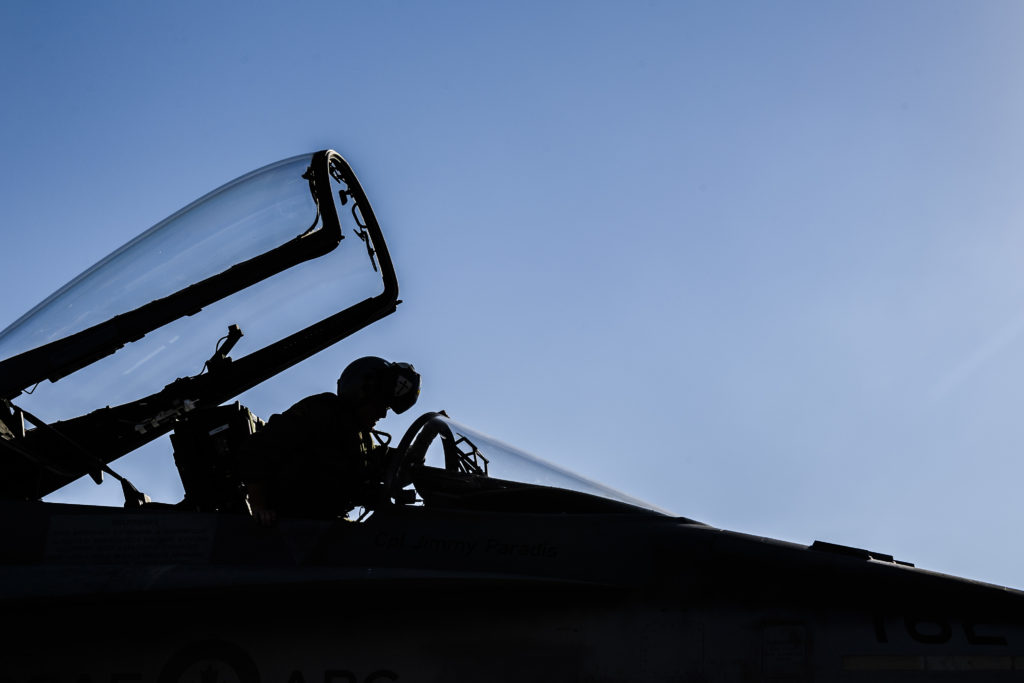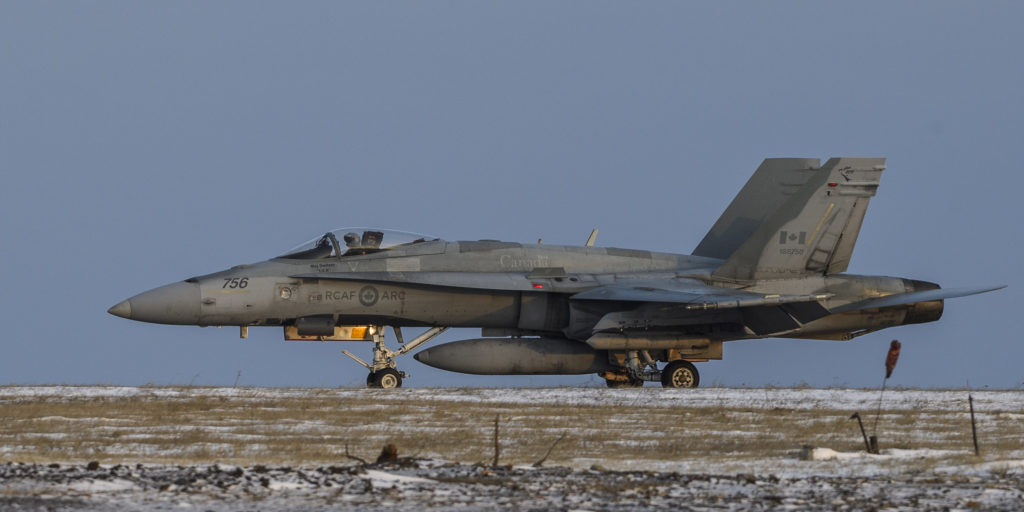Estimated reading time 8 minutes, 50 seconds.
On the night of Oct. 18, 2018, two CF-188 Hornets intercepted a Russian Su-27 Flanker operating near the western half of the Black Sea.
The fighter jets were part of an air task force conducting NATO enhanced air policing in partnership with the Romanian Air Force. They were scrambled by NATO’s southern Combined Air Operations Centre (CAOC) in Torrejon, Spain, to identify an unknown aircraft entering the edge of the Romanian flight information region by the Control and Reporting Centre of the Romanian Air Force.

“I happened to be on alert that day, much to the chagrin of the younger guys,” LCol Tim Woods, the air task force commander, told Skies of the rare encounter with the much bigger Russian aircraft.
“It is quite a bit larger than our F-18s. I flew right up alongside him, got the imagery of the intercept. The interaction was very professional. I took a look at his airplane to see what weapons he had on board and then I waved to him, he waved to me, he gave me a thumbs up, I gave him a thumbs up, he pulled up a camera and took a picture of the two Hornets, presumably for his intelligence people, then we left him there. He was on his way back to Crimea at that point.”
The incident was the only intercept of a Russian fighter jet during the four-month mission, which began on Sept. 1 and will conclude on Dec. 31. But the five Royal Canadian Air Force (RCAF) Hornets have been scrambled multiple times with their Romanian counterparts to patrol designated combat areas after possible aircraft were detected near Romanian airspace.
The mission is a familiar one to Canadian pilots who routinely perform quick react alert duty for NORAD. Jets will scramble in response to an unknown or non-responding aircraft, identify it and shadow or escort it out of sovereign airspace, or offer assistance if required. The difference, said Woods, is the volume of activity.
“The aircraft we see [on NORAD duty] is not that frequent just because of the distances. And what we do see tends to be longer-range Russian surveillance aircraft or bombers. [In Romania], because of the Black Sea and the proximity to Crimea, it is a very busy air sector.”

The fact the air task force (ATF) commander was flying the night of the intercept is an indication of how the pilot and technician shortage is affecting the fighter community. The loss of experienced pilots, identified in the recent Auditor General’s report on Canada’s fighter capability, tends to impact squadron training at home first as the squadron pushes resources forward to support the mission.
But it means “I’m having to fly more as the CO [here] to train the new guys than I would have in the past,” acknowledged Woods, the commanding officer of 425 Tactical Fighter Squadron at 3 Wing Bagotville, Que., which comprises most of the ATF. “Don’t get me wrong, I’m happy to fly more. But it certainly makes my schedule a lot busier.”
This is the second time in as many years that the RCAF has deployed an air task force to the air base in Constanta. Canadian CF-188s first arrived at the 71st Air Base in Campia Turzii in 2014 for a bilateral training mission focused on interoperability with the Romanian Air Force. The mission was upgraded to include enhanced air policing when an air task force commanded by LCol Mark Hickey deployed to Constanta in the fall of 2017.
RCAF Hornets have also led NATO Baltic air policing missions over Lithuania in 2014 and more recently over Iceland in the spring of 2017.
To help mitigate maintenance concerns with the 35-year-old Hornets, the ATF deployed with five CF-188s instead of four.

“That is part of the lessons learned that came from the previous mission,” explained Woods, noting that while the maintainers have a very good understanding of the most common problems likely to arise with the Hornets and come prepared, some parts still have to be ordered from Canada. “It’s good to have that fifth jet if there are delays shipping the part.”
Woods was part of the air task force in 2014, serving as the weapons officer for 425 Tactical Fighter Squadron that made up the aircrews and maintenance technicians, and said the relationship and learning with the Romanians has continued to strengthen with each deployment.
“Since they [recently] acquired F-16 [Fighting Falcons from Portugal], we’re helping them with some of their tactics development. They are moving to a western fighter versus [their older] Soviet MiG-21 Lancers, so there is a shift in the technology and the generation of aircraft,” he said.
“It is mutual. We are learning stuff from them. There are some things they have taught us that we want to adopt, [on how] to run intercepts, for instance.”
In addition to the Romanian aircraft, the CF-188s also conducted training with United States Air Force F-15s in the area, NATO airborne early warning and control aircraft (AWACS), and American joint terminal attack controllers during close air support exercises.

As with the 2017 iteration of the air task force, RCAF air controllers were integrated with the Romanian control and reporting centre in Bucharest to provide liaison and help develop a shared common air picture.
“That is a great relationship that has worked out really well again this year. It helped us be more effective for NATO and Romania,” said Woods. An RCAF officer posted to the NATO CAOC in Spain was also instrumental in helping the mission, he added.
The Su-27 intercept aside, Woods said a highlight of the deployment was marching with the Romanian Air Force through the streets of Bucharest on Dec. 1 for Great Union Day, the centennial of the national holiday marking the unification of Transylvania, Bessarabia, and Bukovina with the Romanian Kingdom in 1918.
“I could not believe how many Romanians recognized the Canadian flag and said, ‘Bravo Canada.’ It was pretty impressive. They hold us in high regard and we certainly hold them in high regard.”
It’s a relationship that will continue to grow. The Canadian Armed Forces is currently planning to deploy an enhanced air policing task force to Romania again in the fall of 2019.








